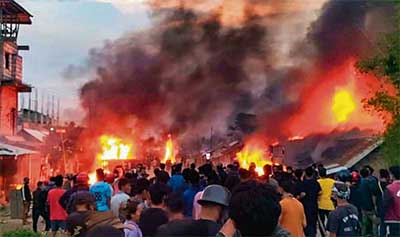Date : 10/08/2023
Relevance: GS Paper 1 - Society - communalism
Keywords: Divide and Rule Policy, Communal Award (1932), Communal violence
Context-
- The recent outbreak of violence in the Nuh district and Gurgaon, Haryana, has not only highlighted the persistent issue of Hindu-Muslim clashes in India but also unveiled a new dimension in terms of its nature, consequences, and underlying factors. While the region's economic challenges are often cited, this violence is better understood as an outcome of competing identities within a polarised political landscape. This analysis delves into the multifaceted anatomy of the riots, considering factors such as historical context, state response, communalism, and ideological influences,
What is Communalism?
Communalism, in a broad sense, means a strong attachment to one’s own community. In popular discourse in India, it is understood as an unhealthy attachment to one’s own religion.
Competing Identities and Polarization:
- The violence in Nuh district and Gurgaon emerges as a reflection of competitive identity assertion within a polarized political environment. Amid a polity that offers varied patronage to non-state actors, the assertion of identities becomes a trigger for conflict.
- The historical institutionalized riot system (IRS), as proposed by scholar Paul Brass, offers a framework for understanding the spontaneity and scale of the violence.
State Response and Ideological Intent:
- The state's response to the riots showcases a concerning ideological intent, as highlighted by the Haryana and Punjab Court's observation labeling it "ethnic cleansing." This response accentuates the deeper penetration of polarised politics in various realms of the state and society, contributing to the escalation of violence.
Prayers Controversy and its Implications:
- The controversy surrounding prayer offers valuable insights into the dynamics of communal tension. While claims of public inconvenience hold some validity, similar inconveniences arise from other religious processions.
- Mutual accommodation and respect have historically mitigated these issues. However, now rising intolerance in society is concern for just society and fraternity mentioned under our constitution.
The evolution of communalism in India
Several key incidents and policies have played a crucial role in this evolution:
- Divide and Rule Strategy: The British colonial rulers employed a "divide and rule" policy, deliberately fostering divisions among different communities to maintain control. By pitting communities against each other, they sowed the seeds of communalism, leading to animosities and conflicts.
- Partition of Bengal (1905): The British decision to partition Bengal along religious lines in 1905 exacerbated communal sentiments. This move created a Muslim-majority province in the east and a Hindu-majority province in the west, intensifying religious identities and tensions.
- Communal Award (1932): The introduction of the Communal Award by the British government in 1932 allocated legislative assembly seats based on population proportions of different marginalized communities. While aiming to address social imbalances, it inadvertently reinforced communal identities and divisions.
- Appeasement Policies: The British administration's policies of appeasement, favoring specific communities for political gain, added fuel to communalism. This selective treatment generated feelings of alienation and unequal treatment among various groups.
Factors Contributing to Communal Violence
- Communal violence often stems from divisive politics that exploit religious and cultural differences to achieve political goals.
- Economic disparities, including uneven development, poverty, and unemployment, leave communities vulnerable to manipulation.
- Historical precedent, where past riots create a breeding ground for future conflicts, and the politics of appeasement also play significant roles. Moreover, isolation and economic backwardness within the Muslim community, coupled with resurgent Hindu-Muslim economic competition, further fuel communal tensions.
- Administrative weaknesses, psychological factors like lack of inter-community trust, and the media's role in disseminating sensationalism contribute to the volatile environment.
Measures to Address Communalism
- To mitigate communal violence, comprehensive measures are imperative. These encompass judicial reform for speedy trials and compensation to deter violence. Inclusive law enforcement involving increased representation of minorities and enhanced human rights training can help bridge divides.
- Specialised training for police units to manage riots and specialized investigation teams can aid in prompt intervention.
- Emphasizing value-oriented education in schools that promotes peace, secularism, and humanism is crucial.
- Early-warning systems modeled after successful initiatives like Malaysia's Mesra can help monitor tensions.
- Encouraging civil society involvement, implementing minority welfare schemes, and proactive efforts by organizations like the National Foundation for Communal Harmony (NFCH) can foster unity and prevent communal conflicts.
- Additionally, legislative action such as enacting the Communal Violence (Prevention, Control, and Rehabilitation of Victims) Bill, 2005, can provide a legal framework to curb communal strife and promote harmony.
Conclusion:
The recent riots in Nuh and Gurgaon expose a worrying pattern of targeting minorities in a polarized political climate. The interplay of competing identities, state response, ideological influences, and communal dynamics underscores the complexity of the situation. As long as sincere secular interventions are absent, the risk of violence remains a looming threat. A comprehensive approach, addressing both communal tensions and the underlying economic challenges, is crucial to preventing the recurrence of such tragic events.
Probable Questions for UPSC Main exam-
- Define communalism in the Indian context and discuss its historical evolution. Analyze the factors responsible for communal violence, highlighting both the socio-economic and political aspects. (10 Marks,150 Words)
- Examine the recent outbreak of violence in Nuh and Gurgaon, Haryana, in the context of communalism and political polarization. Evaluate the state's response, ideological influences, and controversies surrounding issues. (15 Marks,250 Words)
Source : The Indian Express








